
This Week’s Sky at a Glance, May 27 –
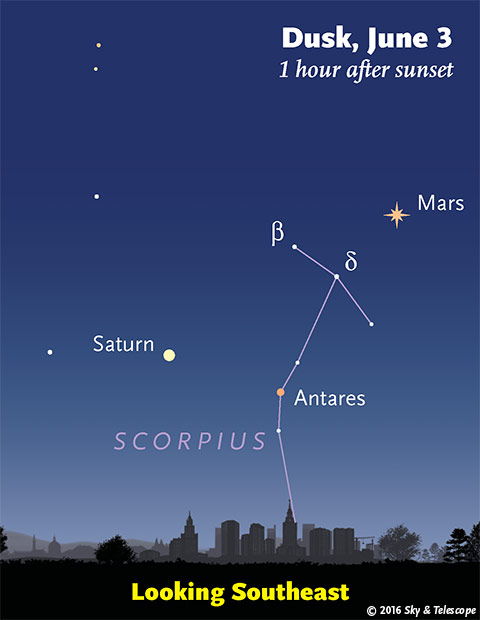
All week Mars, Saturn, and Antares draw the eye southeast at nightfall. . .
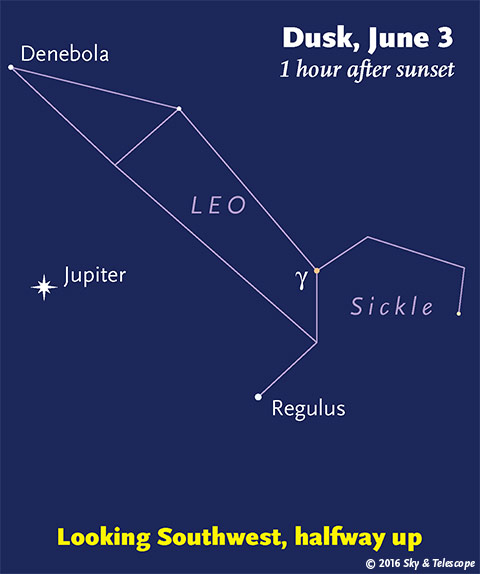
. . .while Jupiter shines under Leo in the southwest.
Friday, May 27
• Have you been watching the Mars-Antares-Saturn triangle change shape? It's stretching as Mars moves westward away from the head of Scorpius. This will continue until the end of June. Then Mars will start to slingshot back to fly right between Antares and Saturn in late August. Plan to watch this slow summer drama!
• Jupiter's Great Red Spot transits Jupiter's central meridian tonight around 2:02 a.m. Eastern Daylight Time; 11:02 p.m. Pacific Daylight Time. It's positioned in good view for about an hour before and after transiting.
Saturday, May 28
• Constellations seem to twist around fast as they pass your zenith, if you're comparing them to the direction "down." Just a week ago, the Big Dipper floated horizontally in late twilight an hour after sunset (as seen from near 40° N latitude). Now it's strongly tilted at that time, bowl down. Another two weeks and it will be hanging straight down by its handle.
• Jupiter's Great Red Spot transits Jupiter's central meridian around 9:54 p.m. EDT.
Sunday, May 29
• Last-quarter Moon (exact at 8:12 a.m. EDT). Tonight the Moon doesn't rise until around 2 a.m. It'll be between the Aquarius's dim spilling bucket and the dim Circlet of Pisces.
• With the Moon gone from the evening sky, meanwhile, hunt out the little-known galaxy bunches at the legs of Virgo using Sue French's Deep-Sky Wonders article, charts, and photos in the June Sky & Telescope, page 54.
Monday, May 30
• Mars is closest to Earth tonight (0.503 a.u.) and appears 18.6 arcseconds in diameter, though for all practical purposes it remains this close for at least another week. Cloudy? You can watch a live telescopic feed from Slooh tonight from 9 to 10 p.m. EDT (1:00 to 2:00 May 31st UT).
• Jupiter's Great Red Spot transits Jupiter's central meridian around 11:33 p.m. EDT. Just off Jupiter's eastern limb, Ganymede disappears into eclipse by Jupiter's shadow around 9:48 p.m. EDT, then re-emerges somewhat farther east of the planet around 12:59 a.m. EDT. Meanwhile, Io reappears out of eclipse in the same general area at 12:27 p.m. EDT.
Tuesday, May 31
• As darkness arrives these evenings, look south about halfway between Jupiter and Mars. One star there stands out: Spica, in Virgo. High above it shines brighter Arcturus in Bootes. Half as far to Spica's lower right is the constellation Corvus, the Crow, eyeing Spica to steal it from Virgo's hand as she looks the other way.
Wednesday, June 1
• Is your sky dark enough for you to see the Coma Berenices star cluster naked-eye? As soon as twilight is completely over, look above Jupiter by about 25°, about two and a half fists at arm's length. The cluster is dim but big, at least 5° wide, the size of a golf ball at arm's length. Its brightest stars, near its middle, form a sort of inverted Y shape. Binoculars bring its stars right out.
Thursday, June 2
• Now it's Saturn's turn at opposition. It's the second-brightest point in the area of Mars, 16° to Mars's lower left.
Friday, June 3
• For much of the spring at mid-northern latitudes, the Milky Way lies right down out of sight all around the horizon. But watch the east now. The rich Cepheus-Cygnus-Aquila stretch of the Milky Way starts rising up all across the east late these nights, earlier and higher every week.
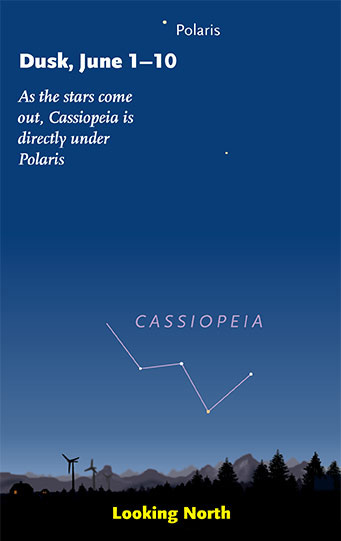
Cassiopeia inches along sideways low in the north at dusk.
Saturday, June 4
• "Cassiopeia" usually means "Cold!" Late fall and winter are when this landmark constellation stands high overhead (seen from mid-northern latitudes). But even on hot June evenings it still lurks low. After dark, look for it down near the north horizon: a wide, upright W. The farther north you are the higher it'll appear, but even as far south as San Diego and Atlanta it's completely above the horizon.
• New Moon (exact at 11:00 p.m. EDT). A new lunar month begins. Unlike a calendar month, which averages 30.437 days long, a lunar month (from one new Moon to the next) averages 29.531 days. So, on average, you'll see the Moon in the same phase about 1 day earlier every month bu the calendar.
_________________________
Want to become a better astronomer? Learn your way around the constellations. They're the key to locating everything fainter and deeper to hunt with binoculars or a telescope.
This is an outdoor nature hobby. For an easy-to-use constellation guide covering the whole evening sky, use the big monthly map in the center of each issue of Sky & Telescope, the essential guide to astronomy.
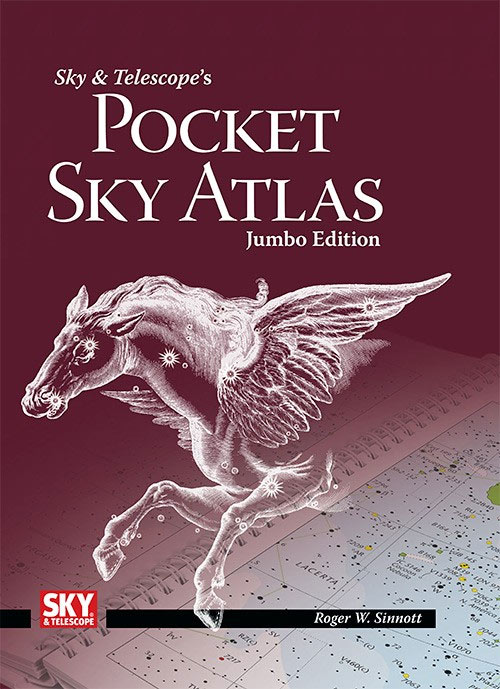
The Pocket Sky Atlas plots 30,796 stars to magnitude 7.6 — which may sound like a lot, but it's less than one per square degree on the sky. Also plotted are many hundreds of telescopic galaxies, star clusters, and nebulae. Shown above is the new Jumbo Edition for easier reading in the night. Click image for larger view.
Once you get a telescope, to put it to good use you'll need a detailed, large-scale sky atlas (set of charts). The basic standard is the Pocket Sky Atlas (in either the original or new Jumbo Edition), which shows stars to magnitude 7.6.
Next up is the larger and deeper Sky Atlas 2000.0, plotting stars to magnitude 8.5, nearly three times as many. The next up, once you know your way around, is the even larger Uranometria 2000.0 (stars to magnitude 9.75). And read how to use sky charts with a telescope.
You'll also want a good deep-sky guidebook, such as Sue French's Deep-Sky Wonders collection (which includes its own charts), Sky Atlas 2000.0 Companion by Strong and Sinnott, or the bigger Night Sky Observer's Guide by Kepple and Sanner.
Can a computerized telescope replace charts? Not for beginners, I don't think, and not on mounts and tripods that are less than top-quality mechanically (meaning heavy and expensive). And as Terence Dickinson and Alan Dyer say in their Backyard Astronomer's Guide, "A full appreciation of the universe cannot come without developing the skills to find things in the sky and understanding how the sky works. This knowledge comes only by spending time under the stars with star maps in hand."
This Week's Planet Roundup
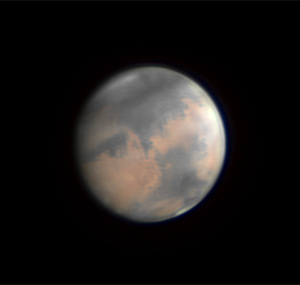
Mars was 14.4 arcseconds wide on April 19th when Phil Miles of Queensland, Australia, took this image with a 20-inch reflector. South is up. Dark Sinus Sabaeus and Sinus Meridiani extend in from the left (preceding). The pointy peninsula a bit farther right is the Oxia Palus region. Lower right from there are big Niliacus Lacus and Mare Acidalium. The North Polar Cap has almost shrunken away in the northern-hemisphere summer. Clouds appear in the wintry far south and especially around the morning limb.
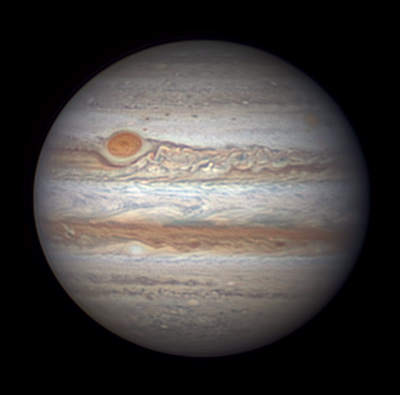
Jupiter as imaged by Christopher Go on May 15th with a 14-inch scope. South is up. The Great Red Spot remains vivid. Dark material lines the Red Spot Hollow like eye shadow.
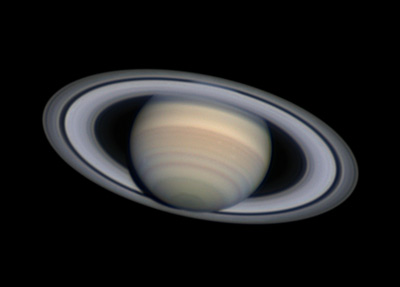
Saturn's rings are wide open this season, tipped 26° to our line of sight and extending above the planet's north and south poles. Damian Peach took this image with a 14-inch Schmidt-Cass on March 19th. South is up.
Mercury is hidden deep in the glow of sunrise.
Venus is lost behind the Sun.
Mars is at its closest to Earth in a decade all this week and next (exactly closest on May 30th). It's the bright yellow-orange thing (magnitude –2.0) low in the southeast during evening, shining at the head of Scorpius. Mars was at opposition on May 22nd; it's getting a little higher each evening. After dark, Mars burns just about as brightly as white Jupiter does in the southwest.
Look lower left of Mars at nightfall, by about 12°, for Saturn and (lower) orange Antares. The Mars-Saturn-Antares triangle stands highest in the south around midnight or 1 a.m. daylight-saving time, when they're likely to appear their sharpest in a telescope.
Mars appears 18.4 to 18.6 arcseconds in diameter this week and next, the biggest and best we'll see it until July 2018. See our telescopic guide to Mars, with map, in the April Sky & Telescope, page 48, or the version online. And set our Mars Profiler for your time and date. If you're ambitious and have a big scope, now's the time to hunt Phobos and Deimos, the two tiny Martian moons, using the June Sky & Telescope, page 48.
Jupiter (magnitude –2.1, in southern Leo) stands high in the southwest during twilight and moves lower as the evening progresses. See our telescopic guide to Jupiter in the March Sky & Telescope, page 48.
Saturn (magnitude +0.1, in southern Ophiuchus) comes to opposition on the night of June 2nd. It shines lower left of Mars in the evening. Look to Saturn's lower right for Antares. See our telescopic guide to Saturn in the June Sky & Telescope, page 48.
Uranus is still veiled by the glow of dawn.
Neptune (magnitude 7.9, in Aquarius) is fairly well up in the southeast just before dawn begins.
__________________________
All descriptions that relate to your horizon — including the words up, down, right, and left — are written for the world's mid-northern latitudes. Descriptions that also depend on longitude (mainly Moon positions) are for North America.
Eastern Daylight Time (EDT) is Universal Time (UT, UTC, or GMT) minus 4 hours.
__________________________
“This adventure is made possible by generations of searchers strictly adhering to a simple set of rules. Test ideas by experiments and observations. Build on those ideas that pass the test. Reject the ones that fail. Follow the evidence wherever it leads, and question everything. Accept these terms, and the cosmos is yours.”
— Neil deGrasse Tyson
https://linksredirect.com/?pub_id=11719CL10653&url=https://www.shoppersstop.com/brand/life%3Fsort=price-asc%26q=%253AcategoryRelevance%253AinStockFlag%253Atrue%253Abrands%253ALIFE%26startRange=%26endRange=%23


No comments:
Post a Comment